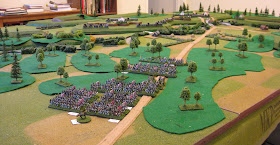Neil Thomas' WARGAMING NINETEENTH CENTURY EUROPE 1815-1878
Having an interest in 19th Century warfare in general and the Second Italian War of Independence in particular, I recently bought Thomas' book. Wargaming 19th Century Europe is my first Thomas wargaming book so I didn't know what to expect. Existing reviews are lacking the detail needed to make an informed decision but I plunged ahead anyway on the road to discovery.
Although the book covers a wide span of history (some might argue too large since weapons and tactics evolved throughout this period), Thomas justifies his position by reminding the reader that the mindset of commanders during this period remained practically unchanged. That is, commanders continued employing Napoleonic tactics over this 60-year span. This same argument could be made for the American Civil War as well.
Thomas provides a comprehensive examination from a wargaming perspective. Thomas breaks the book into a number of manageable chunks. These components include sections on:
- Historical background
- Design notes
- Wargame rules
- Generic scenarios
- Army lists
- Historical scenarios
- Appendices listing bibliography, scales and figure discussion, and wargame related vendors
- Units and Formations
- Basing
- Sequence of Play
- Changes of Formation
- The Charge Sequence
- Movement
- Firing
- Hand-to-Hand Combat
- Morale
The rules' mechanisms lean decidedly towards the simple end of the wargame complexity scale and Thomas defends this approach throughout his design notes chapter (entitled, Nineteenth-Century Wargaming). Thomas emphasizes the "simple" rules' design approach to allow players to focus on the game rather than the rules. The rules have no specified time or figure scale.
All units of the same type are the same size regardless of historical doctrine. Unit size is,
- Infantry - four bases
- Skirmishers - two bases
- Cavalry and Dragoons - four bases
- Artillery - one base
Basing guidelines are provided but any basing scheme should work as long as both combatants are based similarly.
One interesting step in the Sequence of Play is that formation change is a separate step and that infantry may not move in line. The result is that infantry may only charge to contact while in column. Only infantry and artillery may change formation.
In the Charge Sequence, Thomas provides a matrix for easily determining whether a charging unit may contact a defending unit. Conditional charges are allowed provided that the charging unit outnumbers the target. If attacked frontally, defenders may fire at the attacker before hand-to-hand combat is resolved.
In the Charge Sequence, Thomas provides a matrix for easily determining whether a charging unit may contact a defending unit. Conditional charges are allowed provided that the charging unit outnumbers the target. If attacked frontally, defenders may fire at the attacker before hand-to-hand combat is resolved.
In the Fire Phase, firing units throw a number of dice per stand dependent upon unit type (rate of fire). Ranges are singular per weapon type with the exception that smoothbore guns have both a short and long range, and skirmishers add 8cm to weapons' range. Hits are cross-referenced with respect to firing unit and target. For example, an infantry unit firing in line against an infantry in close order line needs 4-6 on each D6 to score one hit. Each base may take four hits before removing one base. Saving throws are allowed for provided the target unit is either in cover (woods or towns) or armed with breechloading weapons. The rationale for the breechloading saving throw is to model the tendency for breechloading armed troops to "go to ground" when under heavy fire.
In Hand-to-Hand Combat Phase, each unit totals the number of dice it throws against its opponent with each stand receiving a set number of dice dependent upon the attacking and defending unit types. Like fire, saving throws are allowed for units in woods or towns. The side taking the largest number of hits retreats after Hand-to-Hand.
During the Morale Phase, only three conditions trigger a morale test. These conditions are:
- Losing a base through fire combat
- Charging cavalry takes fire from defending target
- Losing Hand-to-Hand combat
- Fanatic
- Elite
- Average
- Levy
- Rabble
To me, the most interesting portion of Thomas' book is contained in his design notes in chapter 2. This chapter allows the reader insight into Thomas' rationale for designing the rules as written. Some thought provoking ideas are surfaced within and prompts me to consider some of my own gaming designs. Thomas' rules definitely possess the flavor of classic, Old School wargames as handed down from the pioneers of Featherstone, Grant, Wesencraft, and Morschauser.



















































